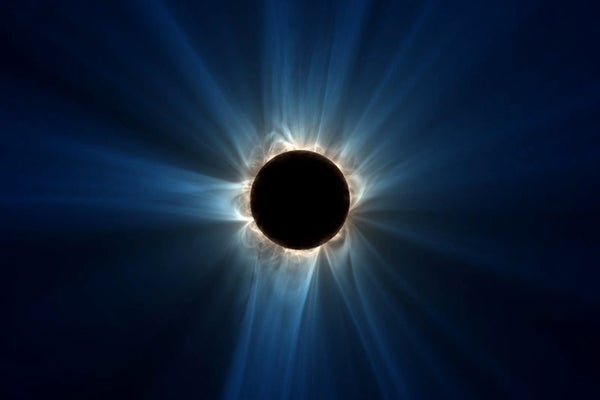Solar Eclipse Will Reveal Stunning Corona, Scientists Predict
Predicting what the sun will look like during a total solar eclipse is a helpful exercise for scientists in the long quest to understand how our star works

Predictive Science Inc.’s prediction one week in advance of what the sun’s magnetic field will look like on eclipse day, April 8, 2024.
This article is part of a special report on the total solar eclipse that will be visible from parts of the U.S., Mexico and Canada on April 8, 2024.
Solar eclipse chasers have good reason to hope for a particularly spectacular sight on April 8 when the moon briefly passes in front of the sun.
But not everyone is content to wait until the big moment to see what the sun will look like. A team of scientists is using supercomputers and extra-fresh data to predict the appearance of the sun’s outer atmosphere, or corona. The region is only apparent during a total solar eclipse, when the moon precisely blocks out the light from the sun’s visible surface, so the exercise allows scientists to test their understanding of how the sun’s magnetic field governs the star’s atmosphere.
On supporting science journalism
If you’re enjoying this article, consider supporting our award-winning journalism by subscribing. By purchasing a subscription you are helping to ensure the future of impactful stories about the discoveries and ideas shaping our world today.
And these days that magnetic field is super active, making it extra difficult for researchers to anticipate the view of the corona. “We knew going into this that the sun is very dynamic now. It’s near the maximum phase of the solar cycle,” says heliophysicist Jon Linker, president and senior research scientist at Predictive Science Inc. He and his colleagues first ventured into modeling the corona during eclipses in the mid-1990s. The basic physics reflected in the process has remained constant for three decades, although the calculation technology and input data have advanced considerably.
And this year the team is tackling a new challenge: continuously updating the prediction as new data come in. In previous years Linker and his colleagues have used magnetic field data gathered about 10 days before the eclipse instead. But this year the simulation will be running for about three weeks total. The exercise has been enlightening, he says. “We can already see that the corona that we’re predicting on eclipse day now has differences from the corona we would have predicted at the start of our calculations,” Linker says.
Linker and his colleagues are making predictions for both the magnetic field at the time of the eclipse and Earth’s view of the corona. Although humans can’t see magnetic fields, eclipse watchers should expect to see a view of the corona that is somewhat in between the two simulations, Linker notes, because human eyes can pick up more detail and structure in the corona during totality than is visible in the basic white-light coronal predictions. (Before and after totality, remember to wear eclipse glasses to protect your eyes when looking at the sun.)
Another helpful feature on the team’s website shows how the sun will appear from any point along the path of totality. That’s valuable because the sun’s orientation changes as seen from different locations on Earth, with a nearly 90-degree rotation visible between western Mexico, where the moon’s shadow will first make landfall, and eastern Canada, the last bit of land to see totality.
Unlike Earth’s magnetic field, which stems from the planet’s core and is more or less stable at human timescales, the sun’s magnetic field warps and un-warps itself over an 11-year cycle as the star rotates. From that changing magnetic field arises a pattern in the team’s predictionsof dramatic white spikes interspersed by dark gaps. This eclipse will be a sharp contrast to the 2017 coast-to-coast eclipse across the U.S., when the sun was near the minimum of its cycle and the corona was calmer and less structured.
Even in an era when several spacecraft are dedicated to watching the sun, an eclipse is a unique opportunity to understand our star—particularly its lower corona. No human-made instrument is as good as a total eclipse at blocking out only the sun’s visible disk and nothing more to reveal the entire corona. “There’s never been an occulting disk like the moon—it is the best occulting disk ever,” Linker says.
Still, the prediction project has benefitted greatly from recently launched spacecraft. This year the predictions will incorporate data from the Solar Orbiter, a mission from the European Space Agency that launched in 2020 and is designed to offer a rare view of the star’s poles. The probe will offer a valuable glimpse of the sun’s magnetic field from a different perspective than most available observations, which have been made along a direct line between the sun and Earth.
Predicting the sun’s corona during an eclipse isn’t just a neat trick. It requires an understanding of the sun’s magnetic field—the same magnetic field that governs outbursts of plasma and radiation that can affect life on and around Earth. These phenomena, collectively called space weather, can jeopardize navigation and communication satellites in orbit, as well as the power grid. But unlike with terrestrial weather, scientists can’t yet make accurate advanced forecasts for space weather.
Linker hopes his team’s predictive work, particularly this year’s adventure in continuous modeling, will bring scientists one step closer to that goal, he says. “This new paradigm for modeling, we think, is really exciting for future space-weather forecasting because this is much more akin to how meteorological forecasts are done.”

